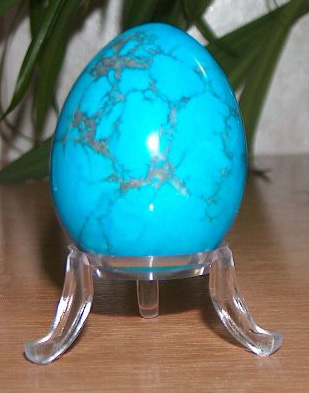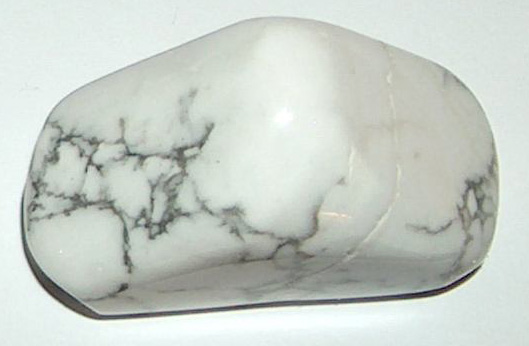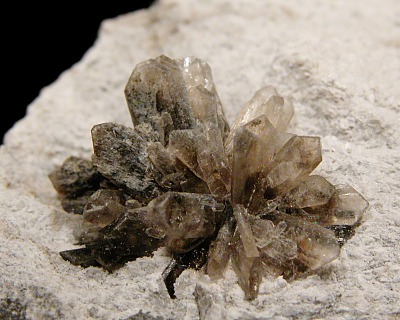Howlite
Howlite (other names howelite, khaulite, silicoborocalcite, winkworthite) is a mineral with the curious distinction (if it can be called a distinction) that, unlike other semi-precious stones which are imitated, howlite is often used to imitate.

Dyed Howlite
Photo by Grzegorz Framski
- image lic. under Creative Commons 2.5 License
Howlite, in its natural form is typically opaque white, patterned with a network of vein-like brown or black lines. However it is sometimes dyed blue to the color of turquoise. I have also seen it colored to imitate malachite, coral or even lapis lazuli. Howlite may also be dyed other colors simply to create brightly colored beads or stones, without necessarily attempting to mimic any particular stone.
Despite this stain (pun intentional) on its reputation, howlite in pure form can be an attractive mineral in its own right - and is often fashioned into objects such as spheres, eggs, pyramids cabochons or statuettes. These are typically inexpensive, and howlite objects can be obtained for a few dollars.
Howlite is a relatively soft stone (3-3.5 Mohs) and fluoreseces bright sky blue under long wave UV light. [1] It has the chemical formula Ca2[SiB5O9(OH)5]. [2] It has been found in Nova Scotia and New Brunswick (Canada), California (USA), Germany, Mexico, Serbia, Slovakia and Turkey. The majority of the material available comes from California, where large howlite pieces (50kg) have been found.
Howlite was named after Henry How (1828-1879), a mineralogist from Nova Scotia who first decribed the species in 1868 in the "Philosophical Magazine and Journal of Science". It has been found in association with ulexite, gypsum and anhydrite. [3]
Although howlite is usally found in opaque form, it can also form small translucent crystals - though these are rare and the opaque form is the one almost always seen for sale at retail. [5]
How To Tell Howlite from Turquoise - some tips
Dyed howlite is a much less expensive subtitute for turquoise and other materials and is sometimes passed off as such by the unscrupulous. Much of the "cheap turquoise" available is said to be howlite. A quick image search for howlite will show pictures of the white natural material and the blue dyed howlite, side by side.
Beware first of all of misnomers. One often sees "howlite turquoise" for sale; note that this material is not a type of turquoise, it is howlite. Also, howlite may be marketed under the name "white turquoise", which is another misnomer. You may also see howlite under the names white buffalo stone, white buffalo turquoise or as turquenite. Note also that there is said to be a "white buffalo turquoise" or "sacred buffalo turquoise" from Nevada, USA - however there appears to be controversy as to the true identity of this stone and whether it even exists. [6]
Due to its patterning, howlite can often look quite similar to real turquoise and be hard to tell apart. Howlite however is a softer material (3-3.5 Mohs) than turquoise (5-6 Mohs), and is much more easily scratched with a knife (although of course, I doubt many dealers would allow you to take a knife to their wares!) Howlite will glow blue under longwave UV (though I have not yet ascertained whether this applies to dyed howlite as well as natural). Howlite also reacts and dissolves with hydrochloric acid. Other chemical tests should be able to distinguish the two: turquoise contains copper, whereas howlite does not. A chemist (I am not one) should be able to devise a chemical test for the presence of copper.
Another useful lead when investigating turquoise is to ask which mine it came from, and who fashioned the object. One source recommends requesting this info in writing from the seller. [7]
As those who create imitation gemstones are often aware of the test procedures and attempt to cover for some of them, more than one test may be needed to tell real stones from fake. The best test of all would of course be to submit the stone to a respected gem laboratory.
Another note - even if you have ascertained that your "turquoise" is not howlite, it may be something else. There are many methods and materials used to imitate turquoise.
Howlite Images

Howlite Pebble
Photo by Grzegorz Framski - image lic. under CC-BY-SA-3.0

Howlite
Crystals
Photo by Ronnie Van Dommelen - lic. under CC-BY-SA-3.0
Howlite - Sources Referenced:
[1] http://webmineral.com/data/Howlite.shtml
[2] "Gemstones Of The World", Walter Schumann (Sterling Press) p.224
[3] http://www.mindat.org/min-1936.html
[4] http://www.gemselect.com/other-info/howlite-gemstones.php
[5] http://en.wikipedia.org/wiki/Howlite
[6] http://gregornot.wordpress.com/2008/07/27/sacred-buffalo-white-turquoise-what-is-it
[7] http://hxdyh.byethost24.com/?p=9&cpage=1
Back to the Gemstones List home page - over 160 gemstones explored!
Please feel free to link to this page - copy / paste the text below: (click to select)
Privacy Policy | Cookie Policy | GDPR | About This Site / Terms

© gemstoneslist.com



